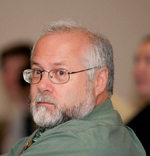
Department of Chemistry and Biochemistry
Associate Professor Emeritus
Research Areas: Organic
Phone: (334)-844-4043
Organic Chemistry: physical organic, photochemistry, photodegrable polymers, strained alkenes
 Organic photochemistry, the interaction of light with organic molecules, represents one of the most exciting fields of chemistry. It is important in medicine, microelectronics, photo-technology, synthetic chemistry and of course the visual and photosynthetic biological systems. The source of all bio-energy is photochemical i.e. the sun, but it is important to realize on a molecular level how much energy is being dealt with. The amount of energy absorbed by a molecule when it interacts with a photon is equivalent in most cases to heating the molecule to over 1000 °C! Yet this photo-excitation usually leads to only certain specific pathways or sometimes to no reaction at all! Our photochemical investigations are designed to try and understand these processes which involve so much energy, but are so specific. To do this the details of the potential energy surfaces of photochemically excited molecules must be understood. It is now felt that most organic photochemical reactions involve funnels (energy minima) on the excited state surface or conical intersections, points where the ground and excited states are degenerate. Both of these features allow the molecule to transit down to the ground state surface, but why does a molecule on an excited state surface choose one pathway over another? We design and examine molecules to delineate the factors (charge, steric and inertia effects) that control entry into funnels or conical intersections on excited state surfaces.
Organic photochemistry, the interaction of light with organic molecules, represents one of the most exciting fields of chemistry. It is important in medicine, microelectronics, photo-technology, synthetic chemistry and of course the visual and photosynthetic biological systems. The source of all bio-energy is photochemical i.e. the sun, but it is important to realize on a molecular level how much energy is being dealt with. The amount of energy absorbed by a molecule when it interacts with a photon is equivalent in most cases to heating the molecule to over 1000 °C! Yet this photo-excitation usually leads to only certain specific pathways or sometimes to no reaction at all! Our photochemical investigations are designed to try and understand these processes which involve so much energy, but are so specific. To do this the details of the potential energy surfaces of photochemically excited molecules must be understood. It is now felt that most organic photochemical reactions involve funnels (energy minima) on the excited state surface or conical intersections, points where the ground and excited states are degenerate. Both of these features allow the molecule to transit down to the ground state surface, but why does a molecule on an excited state surface choose one pathway over another? We design and examine molecules to delineate the factors (charge, steric and inertia effects) that control entry into funnels or conical intersections on excited state surfaces.
The research efforts of our group must then involve synthesis as well as a variety of spectroscopic (matrix isolation IR and UV, low temperature NMR, etc) and computational techniques in order to examine and gain further insights into the properties of these high-energy molecules and into the processes that photochemically excited molecules undergo. Thus, photochemistry is fun and "exciting" chemistry to do, but it also provides a graduate student with a training which is particularly broad-based.
Our current major interests include: 1) the photochemistry of 1,3-dienes which serve as models for the larger polyenes of the visual system; LINKDienes 2) the chemistry of 1-thia-3,4-diazolidine-2,5-diones (TDADs) which show an amazing versatility from the photochemical generation of the hydrogenation reagent diimide and several other interesting reactive intermediates to two types of photodegrable polymers polymers. LINKTDAD 3) photo and chemical synthesis of carbon-carbon double bonds strained by twisting such as trans-cycloheptene; LINKStrained Alkenes
|
Squillacote, M. E.; Chen, J.; Siebert, A. A Silicone Septum as a Connector forSerially Coupled Capillary GC Columns Chromatographia 2009, 69, 771–773. Squillacote, M. E.; Acevedo, O. A New Solvent-Dependent Mechanism for aTriazolinedione Ene Reaction J. Org. Chem. 2008, 73, 912-922. Squillacote, M. E.; Garner, C.; Oliver, L.; Mooney, M.; Lai Y. L.; PhotochemicalGeneration of Aziridinium Imides: Are AIs Bystanders or Perpetrators in the EneReaction? Org. Lett. 2007, 9, 5405-5408. Squillacote, M. E.; DeFellipis J.; Shu, Q. How Stable is Trans-Cycloheptene? J. Amer. Chem. Soc. 2005, 127, 15983-15988. Squillacote, M. E.; Liang, F. Conformational Thermodynamic and KineticParameters of Methyl-substituted 1,3-Butadienes J. Org. Chem. 2005, 70, 6564-6573. |
Last updated: 08/23/2019
